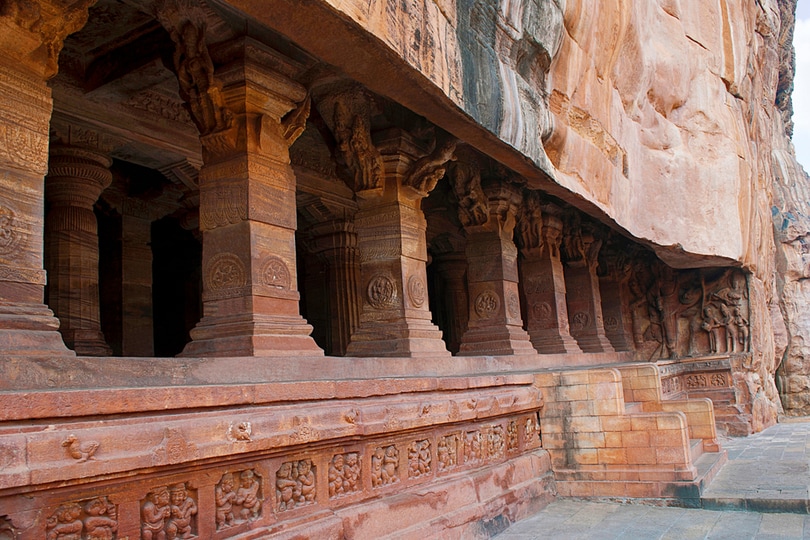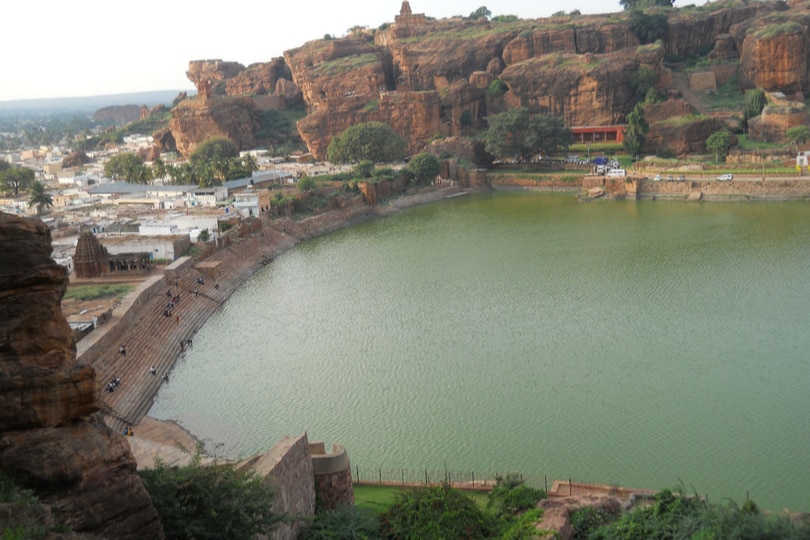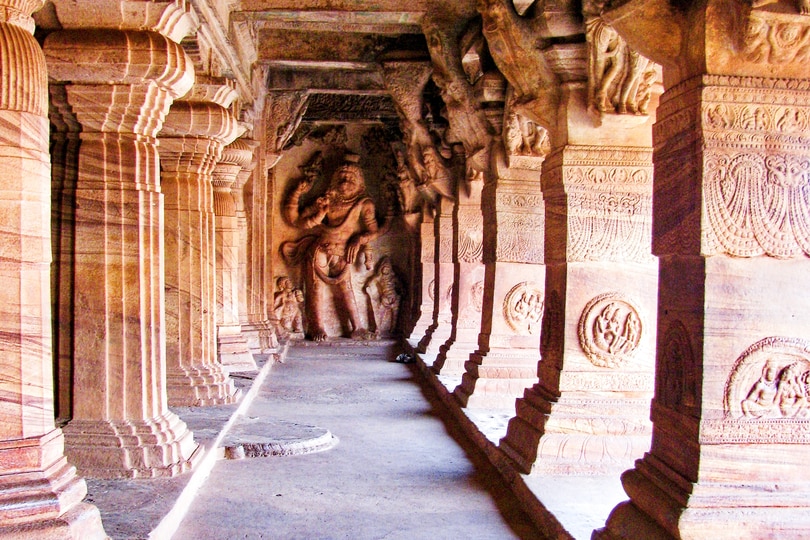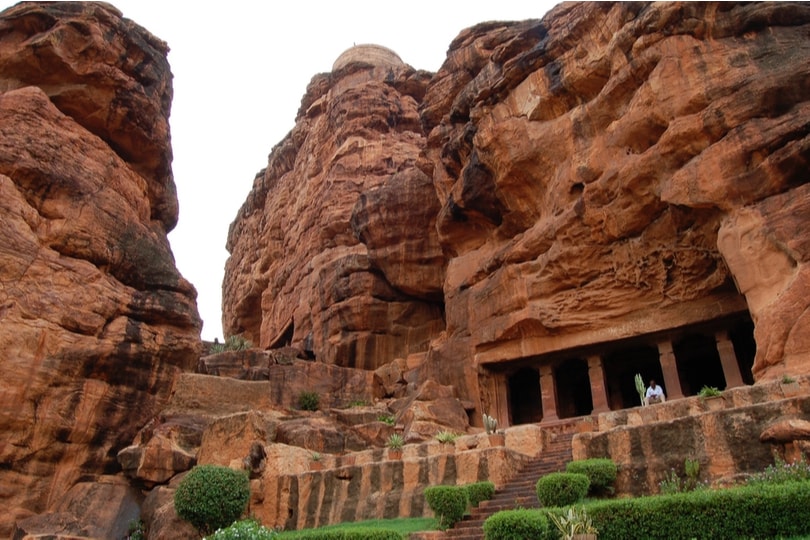An excellent example of Indian rock-cut architecture, the Badami caves are a reminder of India’s rich history of combining art with religion and spirituality. If you want to feel the calmness that comes with spirituality while also wanting to learn about India’s ancient history, you must visit the Badami caves. The Badami Chalukya architectural style that is reflected on the walls of the caves is considered to be one of the most innovative techniques of construction. These 6thcentury caves are situated in Bagalkot, a district located in Karnataka. North and south of these caves lie several forts constructed by later rulers of the Chalukya dynasty and by other rulers of the region. A ringed lake borders one side of these caves, the banks of which are made of an earthen wall fixed with stone steps.
Courtesy of the temples that lie within these caves, the entire valley of the beautiful Malaprabha river has been transformed into an inspiration of Hindu architectural styles utilized for making temples. There are multiple caves scattered throughout the area, making it a mesmerizing sight for tourists. The first four caves are located on the steep slope of the surrounding hills, while many new caves are located around the lake. Most of the caves feature symbolisms of Hindu divinity, including carvings of Lord Shiva in the Tandava Position and the mythological stories from his life. Spiritual stories concerning Vishu and other Hindu deities also find a place at these caves. Some of the recently discovered caves are thought to be dedicated to the propagation of Buddhism and Jainism. However, Hindu carvings remain prominent in the first four and many other caves of the region.

Badami caves have numerous temples numbered according to the chronological order of their formation. The construction of the primary four cave temples can be attributed to the kings of the Chalukya dynasty. Geographical shreds of evidence suggest that the caves were formed around the 6th century. Exact dates of formation, however, are not known for any of the caves except cave 3. You will observe that the caves are full of various inscriptions etched on the walls. One of these inscriptions in cave three records the creation and dedication of the cave temple to Lord Vishnu by a king called Manglesha. The Badami caves are considered as the oldest firmly dated Hindu caves of the country.
The soft Badami sandstone build lends the caves a mesmerizing auburn hue. While here, do not forget to climb on the terraces and steps to catch a picturesque view of the surrounding central city of Bagalkot. Each of the Badami caves has a definite architectural plan for their temples. There is a small porch that leads to the mandapa and then to the garbha or sanctum sanctorum of the temple that is located deep inside the caves. Different brackets support the massive mandapas of the roof, adding a majestic feel to the Dravidian style temples.
Situated about 18 m above the ground level, the first Badami cave reflects Dravidian architectural style at its finest. It is positioned on the north-western side of Badami hills and can be accessed through a series of steppes that depict several mythical figures called Ganas holding the steps. If you are a fan of mythological sculptures, you must explore this cave thoroughly.
A large stone right at the entrance of the cave depicts Shiva as Natraja, a dancing deity in the Tandava position. Historians and Indology experts believe the position of this deity’s 18 arms to be a symbol of the cosmic wheel of time. Right beside this deity are the carvings of Shiva’s son Ganesha and his consort Parvati. The different positions of the Natraja’s hands are known as the various mudras of Indian dance forms. On the left of the carvings that depict Shiva and his family, there exists an etching of a Shaiva dwarapala followed by a bull-elephant hybrid animal. Different jewels, flower motifs, foliage and jewellery designs are also carved intricately amid these deity’s forms. A unique artwork depicting Shiva in his Ardhnarishwar form also finds a place in the cave. Several Yakshas, Apsaras, Nagaraja and the Chalukyas’ family gods have been drawn on the inner walls of the caves.
The actual garbha griha contains a shiva linga. Outside the magnificent sanctum sanctorum is a large sculpture of Nandi who faces it. In this cave, you can learn plenty about Indology, the symbolism of Hindu gods and rituals, and also offer prayers.
Situated right above cave 1, the second cave is a gorgeous depiction of Hindu theology and art. Unlike the first cave, this one is dedicated to Lord Vishnu. Multiple etchings on cave walls signify different stages of Vishnu’s life. All the carvings are laid out symmetrically, often within a circle. The geometric design of the sculptures is a trademark of ancient Hindu architecture. Stories from the Bhagavata Purana, the Samudra Manthan and different religious texts concerning the Lord’s life are narrated through exquisite artwork throughout the caves. If you want a coveted glimpse into the theological richness of India, this cave will satisfy you. The overall architecture will give you a feel of the Deccan Ellora caves, with their bas reliefs and floral motifs.
The third cave is exactly dated and hence titled as the earliest Hindu cave temple known in history. This cave faces the north and is about 60 steps above cave 2. It has several pillars, verandas, columns and brackets that add a regal look to its design. The well-thought-out style has stood tall for centuries and is a spot where you can cherish the real gems of Indian history, religion and culture. This Badami cave is known for its apt depiction of religious stories concerning Vishnu, Brahma and Shiva. Shiva’s consort Parvati is also depicted as Shakti on the wall carvings. Cave 3 is very well preserved as compared to cave 1 and 2 and is a good insight into the culture and lifestyle of the Chalukya kingdoms.
The fourth cave is unique amid the other Badami caves, for it features symbols of Jainism rather than Hinduism. Many Jain Tirthankaras like Parshvanath, Mahavira, Bahubali and Indranbhuti Gautama are also carved in different meditative postures. This cave was constructed in the late 7th century and was supported by the Hindu kings of the region. Several floral and rosette motifs are dotted alongside the religious structures.

Surrounded by red sandstone temples, the Agastya lake is a calm natural getaway where you can both relax and learn of the history of Badami. Visit this lake for a walk along its banks or a view of the sunrise.
The Badami Fort is known to have been constructed by Tipu Sultan. It sits atop a hill and features a watchtower and several extensively decorated pillars and corridors. This fort stands in ruins today but is an excellent tourist spot for history and Indology lovers.
The Archeological Museum of Badami showcases almost every historical tale associated with the Badami caves and temples. It has several galleries and open air-exhibits that will enchant you as you understand the significance of the prehistoric culture of India.

One of the holiest shrines of Karnataka, the Banashankari temple is a serene and divine place where you can offer prayers to the Hindu deity Rahu Kala. Take pictures beside the holy lake that surrounds the temple or meditate in peace in its grand complex.
Badami has a sumptuous cuisine that will tantalize your taste buds. Here, you can taste some amazingly delicious dishes made out of staple Indian grains like Ragi, Jowar, Bajra, and Rice. Urad Dal, Jaggery, and coconut are used in almost all the local dishes. The food is the perfect mixture of sweet and spicy. Do not forget to try dishes like Halwa, Chiroti and Mysore Pak. Elegant fine-dining options in the city are limited, but the local street food is to die for.
Local festivals include an annual dance and music festivals and fetes organized at the Banashankari temple in January or February. The Virupaksha Temple car festival and the Mallikarjuna Temple Festival are other celebrations that will leave you enthralled as you walk around the gorgeous streets of Badami. The local enthusiasm is infectious, and you will be swept off your feet because of the beautiful decorations installed in the city. Apart from the above mentioned, festivals like Holi and Diwali are also celebrated joyfully in the region.
If you love shopping, rosewood and sandalwood sculptures of Badami will be irresistible for you. You can also shop for some religious statues and small replicas of the cave temples. Traditional jewellery, artefacts, rugs and local textiles are more items you can take home after your glorious vacation.

You can easily use cameras and mobile phones at Badami. However, temples in the region might prevent you from carrying them. Check with the authorities regarding the exact camera and mobile phone regulations.
A UNESCO world heritage site, the Badami Caves are an excellent place to learn about the history of the Deccan region of India. The local traditions of the Chalukyas, historical invasions and wars, and their devotion to religion will leave you spellbound. Visit Badami caves to spend your next holiday in a culturally, geographically and historically enriched spot.

Please go back to portrait mode for the best experience